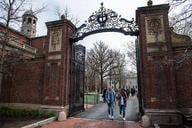You have /5 articles left.
Sign up for a free account or log in.
At every campus sustainability conference -- pretty much in every campus sustainability conversation -- the term "LEED" comes up. LEED is Leadership in Energy and Environmental Design, an evolving set of standards/best practices published and administered by the US Green Building Council. USGBC awards LEED status (certified, silver, gold, platinum) to buildings which have scored various numbers of points in a combination of categories; the categories, criteria ("credits") within those categories, and scales for awarding points change over time since "best practice" is constantly advancing.
One of the key ways colleges and universities present themselves as "green" is by emphasizing the number, and level, of LEED-designated buildings on their campuses. And one of the key early emphases of many campus sustainability plans is to build all new structures, and enhance existing ones, in ways which will facilitate LEED designation.
Getting a building LEED certified is a complex, time-consuming, and moderately expensive process. All claims made must be strictly verified by USGBC; getting it "not quite right" can mean more expense, more time, and a modicum of embarrassment. To avoid any of this, major architectural/engineering/construction firms have key employees with the LEED Accredited Professional, or "LEED-AP", credential. An increasing number of colleges and universities are themselves hiring or training LEED-APs.
Up until recently, the LEED-AP credential hasn't been particularly specialized. Buildings might be registered and certified as new construction or existing structures, but a LEED-AP was pretty much considered a LEED-AP. Most folks got certified for new construction because of the demand from architects, engineers and construction companies.
That's not the case any more. Now, a candidate can register for a LEED-AP test for Operations & Maintenance of existing structures. Starting this summer, additional tests for Building Design & Construction, Interior Design & Construction, and LEED Homes will be available. Next summer, USGBC (or rather, its newborn cousin, the Green Building Certification Institute) is planning to introduce an exam in Neighborhood Design.
Most of the campus-based LEED-APs I know got their certification with a focus on new construction, because that's what there was, and major new construction processes get a lot of attention. But -- unlike architectural firms -- most colleges spend most of their time not building or conducting major upgrade projects. Most of the time, we use our buildings pretty much the way they are. Six months of rehab followed by 25 years of operation seems about par for the course.
For many university employees, then, the current Operations & Maintenance (or "O&M") certification would seem the most beneficial. Standards and practices which focus not on how a building is constructed, but on how it's operated, should shape the actions of Facilities and Physical Plant departments nationwide. The best-designed and -constructed building quickly becomes an energy hog if it's not operated and maintained competently. Similarly, even a poorly-designed or -built structure can be far more energy efficient and provide a far healthier working environment if it's run well.
For campus planners, though, it might well make sense to wait until the Neighborhood Design credential is available. Campuses are self-defining neighborhoods, and the environmental, economic and social benefits of living and working in a sustainably-designed neighborhood would seem to far exceed those available from being in a particular building, no matter how well designed, built and operated. How the neighborhood -- campus and surrounding area -- is designed will affect where people live, where they shop, how long their commute is, how they travel, how often they drive, how healthy they are, how they entertain themselves, how and where they eat, pretty much every aspect of the day-to-day lives of students, faculty and staff.
Given the challenge of making our campuses climate-neutral, our efforts to live and operate sustainably can't be limited by the walls of a single building, or even by the walls (physical or virtual) around what we have thought of as "campus" itself.

